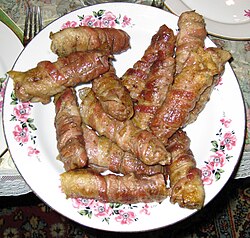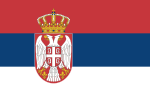| Revision as of 00:08, 25 March 2014 editSematz (talk | contribs)Extended confirmed users2,376 editsmNo edit summary← Previous edit | Revision as of 16:03, 25 March 2014 edit undoAnastan (talk | contribs)Extended confirmed users, Pending changes reviewers2,428 edits Undid revision 601117681 by Sematz (talk)Next edit → | ||
| Line 15: | Line 15: | ||
| | other = | | other = | ||
| }} | }} | ||
| '''Ćevapi''' ({{IPA-sh|tɕɛv̞ǎːpi|pron}}) or '''ćevapčići''' (formal ], {{IPA-sh|tɕɛv̞ǎptʃitɕi|}}, {{lang|sr-cyrl|ћевапчићи}}) is a grilled dish of minced meat, a type of ], found traditionally in the countries of ]. They are considered a national dish in ] |
'''Ćevapi''' ({{IPA-sh|tɕɛv̞ǎːpi|pron}}) or '''ćevapčići''' (formal ], {{IPA-sh|tɕɛv̞ǎptʃitɕi|}}, {{lang|sr-cyrl|ћевапчићи}}) is a grilled dish of minced meat, a type of ], found traditionally in the countries of ]. They are considered a national dish in ],<ref>{{cite web|title=Bosnia and Herzegovina|year=2009|publisher=Encyclopædia Britannica|accessdate=July 27, 2009|url=http://www.britannica.com/EBchecked/topic/700826/Bosnia-and-Herzegovina}}</ref> and ].<ref>{{cite book|url=http://books.google.com/?id=aoVUAAAAMAAJ&q=cevapcici|title=The new Encyclopaedia Britannica: A-ak - Bayes, Volume 1}}</ref><ref>{{cite book|url=http://books.google.com/?id=pssZAQAAIAAJ&q=cevapcici|title=Countries and Their Cultures: Saint Kitts and Nevis to Zimbabwe|page=68}}</ref><ref>{{cite web|publisher=TravelSerbia.Info - Your travel guide for Serbia|accessdate=August 9, 2010|url=http://www.travelserbia.info/serbian-cuisine.php|title=Serbian cuisine}}</ref> They are also common in ], ], ], as well as in ], ], ], ], ], ] and the ]. | ||
| They are usually served of 5-10 pieces on a plate or in a ] ('']'' or ''somun''), often with chopped ]s, ], ], ], ], minced red pepper and salt. Bosnian ćevapi are made from two types of minced ] meat, hand mixed and formed with a funnel, while formed ćevapi are grilled. Serb ćevapčići are made of either beef, ] or ] or mixed. Macedonian, Croatian, Bulgarian and Romanian varieties are often made of both pork and beef. | They are usually served of 5-10 pieces on a plate or in a ] ('']'' or ''somun''), often with chopped ]s, ], ], ], ], minced red pepper and salt. Bosnian ćevapi are made from two types of minced ] meat, hand mixed and formed with a funnel, while formed ćevapi are grilled. Serb ćevapčići are made of either beef, ] or ] or mixed. Macedonian, Croatian, Bulgarian and Romanian varieties are often made of both pork and beef. | ||
Revision as of 16:03, 25 March 2014
 Bosnian ćevapi in somun. Bosnian ćevapi in somun. | |
| Course | Main course |
|---|---|
| Region or state | Balkans |
| Main ingredients | Meat (lamb, or beef, somun, onion |
Ćevapi (Template:IPA-sh) or ćevapčići (formal diminutive, Template:IPA-sh, ћевапчићи) is a grilled dish of minced meat, a type of kebab, found traditionally in the countries of southeastern Europe. They are considered a national dish in Bosnia and Herzegovina, and Serbia. They are also common in Croatia, Montenegro, Slovenia, as well as in Republic of Macedonia, Bulgaria, Romania, Czech Republic, Slovakia, Austria and the Italian provinces bordering Slovenia.
They are usually served of 5-10 pieces on a plate or in a flatbread (lepinje or somun), often with chopped onions, sour cream, kajmak, ajvar, cottage cheese, minced red pepper and salt. Bosnian ćevapi are made from two types of minced beef meat, hand mixed and formed with a funnel, while formed ćevapi are grilled. Serb ćevapčići are made of either beef, lamb or pork or mixed. Macedonian, Croatian, Bulgarian and Romanian varieties are often made of both pork and beef.
Name and etymology
The word ćevap comes from the Persian word kebab, sometimes with the South Slavic diminutive ending -čići (Bosnian, Croatian: ćevapčići/ćevapi; Slovene: čevapčiči/čevapi; Template:Lang-sr; Template:Lang-mk; Template:Lang-bg, Template:Lang-cs). The word ćevapi is plural; the singular form ćevap is rarely used, as a typical serving consists of several ćevapi.
In other parts of the world, such as Australia, they are known by their traditional name as well as the Anglicised and marketing-friendly term "skinless sausages". They are also known as Balkan meatballs.
History

Ćevapčići has its origins in the Balkans during the Ottoman expansion into southeastern Europe and developed through the Middle Ages into a regional specialty similar to the kofte kebab.
In Bosnia, there are varieties of versions of the dish such as e.g. Travnički ćevapi from the traditionally cattle herder area of Travnik, canonical Sarajevski ćevap from Sarajevo area, that look similar but taste slightly different due to variations in seasoning and meat content (some varieties containing lamb or other non-pork meats), as well as Banjalučki ćevapi which differs not only in taste but also by being grilled and served in connected tuples (usually of four). "Tuzlanski ćevapi" served in Tuzla area, come in butter rich soup dipped somun - and have distinctive taste as well as texture of bread. In all cases the dish is kept simple, and traditionally served in somun with onions and/or kajmak and yogurt or kefir as appetizer, whereas outside Bosnia, it's common for ćevapi to be served with variety of vegetables and seasonings.

It is found in the Srpski rječnik (1818). In Serbia, there is a local variety of leskovački ćevap whose recipe is based on traditional Serbian pljeskavica but formed as a somewhat larger sausage (ćevap). It is named after the city of Leskovac, which now organizes the yearly Leskovac Grill Festival as a showcase of ćevapi and other grilled meat. In Belgrade, ćevapčići first came from Leskovac in the 1860s, into the kafana "Rajić" at the Great Marketplace (today Studentski Trg), from where they have quickly spread across the city. Before the 1930s, they spread to the rest of the former Kingdom of Yugoslavia, including east of Serbia and the Macedonia region. In 1933, the first street vendor with food appeared in Maribor, who came from Leskovac, and served grilled meat, including ćevapčići.
In Austria, Czech Republic and Slovakia, čevapčiči is generally served with mustard mixed with finely chopped raw onions and potatoes or French fries, in a common fast food manner.
See also
- Kabab koobideh, Iranian minced meat
- Adana kebabı, Turkish minced meat
- Kebapcheta, Bulgarian minced meat
- Mititei, Romanian minced meat
References
- "Bosnia and Herzegovina". Encyclopædia Britannica. 2009. Retrieved July 27, 2009.
- The new Encyclopaedia Britannica: A-ak - Bayes, Volume 1.
- Countries and Their Cultures: Saint Kitts and Nevis to Zimbabwe. p. 68.
- "Serbian cuisine". TravelSerbia.Info - Your travel guide for Serbia. Retrieved August 9, 2010.
- World and Its Peoples: Western Balkans. p. 1641.
Cevapi is a popular option, served in pita bread and resembling the Turkish doner kebab
- Univerzitet u Novom Sadu. Filozofski fakultet (1974). Godisnjak. p. 173.
Занимљиво је и то „да се у Рјечнику (из 1818 — Ј. К.) не налази већина јела која данас сачињавају оно што се обично зове српском кујном, тако нпр. капама, мусака, папазјанија, пљескавица, ражњићи, ћевапчићи, ћулбастија (али ...
- ^ Darko Spasić, Branislav Nušić. "Прилог историјату ћевапчића" (in Serbian). Srpsko nasleđe.
- Eating Out in Europe: Picnics, Gourmet Dining and Snacks Since the Late Eighteenth Century. 2003. p. 133.
External links
- An essay on ćevapi in BH Dani (in Bosnian)
- The Original Cevapcici by ORF.at
- Recipe for ćevapi
- Bosnian recipe portal
| Bosnia and Herzegovina topics | ||
|---|---|---|
| History |  | |
| Geography | ||
| Governance | ||
| Economy | ||
| Society | ||
| Culture | ||
